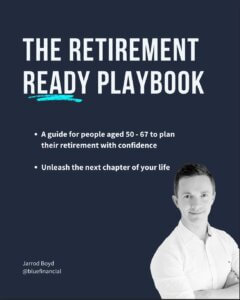Retirement Investing 101: 3 Key Areas to Look at
- Jarrod Boyd

After working hard for most of your life, you deserve to pursue new dreams and make the most of your post-career phase.
The key to enjoying a happy and comfortable retirement is by boosting your retirement funds by investing early. However, knowing where to start can be overwhelming and complicated.
To understand this process easier, here are three key areas to look at:
Diversification
Diversification involves spreading your investments around so that your exposure to any one type of asset is limited with the aim of protecting your investments.
Investment asset classes are grouped into:
- fixed interest
- local and international shares
- cash
- property
- Alternative investments
To minimise risks, you can implement a risk reduction strategy by diversifying these asset classes.
In simpler terms, you might not want to put all your eggs in one basket.
Diversification can be done by investing in multiple asset classes or multiple assets within an asset class. This is especially beneficial for more risk-averse investors interested in gaining investment returns with less volatility.
Since asset classes are affected by general economic and market conditions, some are more volatile than others. This means the value of your initial investment can move up and down frequently.
The asset classes selected affect the level of exposed volatility. How much money you will have during retirement can be influenced by these asset classes, which is why it’s important to choose wisely. Monitoring their performance and volatility is also crucial.
Determine your Investment Risk Tolerance
There is no doubt that when it comes to investing there are chances that you may lose some of the money you invest.
There is always risk associated with investing.
Investment performance can fluctuate from time to time. All assets carry investment risks however, some assets can have a higher risk than others.
Here are some of the main risks that you should be aware of:
- Interest Rate Risk – is a common high risk for fixed interest investments. In general, you should be wary of any significant interest rate changes as it may reduce your returns.
- Market Risk – can be a concern if there are drastic economic changes or other events that affect the entire market.
- Sector Risk – can affect the value of an investment if there are events that affect a specific industry sector.
- Inflation Risk – if the value of your investments doesn’t keep up with the pace of inflation.
Your risk tolerance also may depend on how close you are to reaching your retirement phase. For example, a conservative investment option offers lower risk, which means there is generally less risk of your balance reducing as you approach retirement.
In contrast, younger people with years ahead of their retirement phase, are more likely to choose the growth investment option as it usually achieves a higher return in the long-term.
Commonly, many people choose a growth investment option during their early working years to boost their super, and then switch to the conservative option when nearing their final working days.
However, the perfect strategy for your situation and risk tolerance will be unique to you. Personal financial advice can help you determine your perfect investment strategy.
Investing in your Super
By law, your employer must pay a percentage of your earnings into your super fund, which is referred to as the super guarantee.
However, if you’d like to boost your retirement savings, you can make extra contributions into your super fund.
There are two different types of contributions you can make to your super:
- Concessional Contributions – these are otherwise classified as pre-tax super contributions, where you have the option of asking your employer to sacrifice part of your pre-tax pay into your super fund. This is commonly known as salary sacrificing.
Concessional contributions effectively boost your retirement savings as they are taxed at 15% (lower than your marginal tax rate). However, concessional contributions caps are limited to $27,500 per financial year.
Alternatively, you have the option of making larger concessional contributions (above the cap) if you haven’t used all of your concessional cap in an earlier years. These are called catch up contributions. This can provide greater flexibility to those who may have broken work patterns such as, when going on maternity leave.
- Non-concessional Contributions – are contributions made to your super from your after-tax pay. In each financial year, you can make non-concessional contributions up to $110,000 to your super fund.
Retirement is a part of life that many Australians look forward to. Since your golden years are a time you deserve to enjoy, it just makes sense to prepare for it ahead of time. Unfortunately, many people feel overwhelmed, making them hesitant to invest or even get started in retirement planning.
Thankfully, you now know the basics of the best investments for retirement. To receive more retirement financial advice, seek assistance from trustworthy financial advisors.
Get in touch with Blue Financial for retirement planning services. With our years of experience, you can be assured that we will provide you with financial products that suit your needs.
General Advice Warning: This article contains information that is general in nature. It does not take into account the objectives, financial situation or needs of any particular person. You need to consider your financial situation and needs before making any decisions based on this information.





